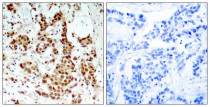ARG51607
anti-p90 RSK phospho (Thr348) antibody
anti-p90 RSK phospho (Thr348) antibody for ICC/IF,IHC-Formalin-fixed paraffin-embedded sections,Western blot and Human,Mouse,Rat
Gene Regulation antibody; Signaling Transduction antibody
Overview
| Product Description | Rabbit Polyclonal antibody recognizes p90 RSK phospho (Thr348) |
|---|---|
| Tested Reactivity | Hu, Ms, Rat |
| Tested Application | ICC/IF, IHC-P, WB |
| Host | Rabbit |
| Clonality | Polyclonal |
| Isotype | IgG |
| Target Name | p90 RSK |
| Antigen Species | Human |
| Immunogen | Peptide sequence around phosphorylation site of threonine 348 (S-R-T(p)-P-R) derived from Human p90RSK. |
| Conjugation | Un-conjugated |
| Alternate Names | p90-RSK 1; Ribosomal S6 kinase 1; MAPKAPK-1a; RSK; p90RSK1; MAPKAPK1A; HU-1; p90S6K; MAPK-activated protein kinase 1a; S6K-alpha-1; MAPKAP kinase 1a; p90Rsk; RSK-1; EC 2.7.11.1; Ribosomal protein S6 kinase alpha-1; RSK1; MAP kinase-activated protein kinase 1a; 90 kDa ribosomal protein S6 kinase 1 |
Application Instructions
| Application Suggestion |
|
||||||||
|---|---|---|---|---|---|---|---|---|---|
| Application Note | * The dilutions indicate recommended starting dilutions and the optimal dilutions or concentrations should be determined by the scientist. |
Properties
| Form | Liquid |
|---|---|
| Purification | Antibodies were produced by immunizing rabbits with KLH-conjugated synthetic phosphopeptide. Antibodies were purified by affinity-chromatography using epitope-specific phosphopeptide. In addition, non-phospho specific antibodies were removed by chromatogramphy using non-phosphopeptide. |
| Buffer | PBS (without Mg2+ and Ca2+, pH 7.4), 150mM NaCl, 0.02% Sodium azide and 50% Glycerol. |
| Preservative | 0.02% Sodium azide |
| Stabilizer | 50% Glycerol |
| Concentration | 1 mg/ml |
| Storage Instruction | For continuous use, store undiluted antibody at 2-8°C for up to a week. For long-term storage, aliquot and store at -20°C. Storage in frost free freezers is not recommended. Avoid repeated freeze/thaw cycles. Suggest spin the vial prior to opening. The antibody solution should be gently mixed before use. |
| Note | For laboratory research only, not for drug, diagnostic or other use. |
Bioinformation
| Database Links | |
|---|---|
| Gene Symbol | RPS6KA1 |
| Gene Full Name | ribosomal protein S6 kinase, 90kDa, polypeptide 1 |
| Background | Serine/threonine kinase that may play a role in mediating the growth-factor and stress induced activation of the transcription factor CREB. |
| Function | Serine/threonine-protein kinase that acts downstream of ERK (MAPK1/ERK2 and MAPK3/ERK1) signaling and mediates mitogenic and stress-induced activation of the transcription factors CREB1, ETV1/ER81 and NR4A1/NUR77, regulates translation through RPS6 and EIF4B phosphorylation, and mediates cellular proliferation, survival, and differentiation by modulating mTOR signaling and repressing pro-apoptotic function of BAD and DAPK1. In fibroblast, is required for EGF-stimulated phosphorylation of CREB1, which results in the subsequent transcriptional activation of several immediate-early genes. In response to mitogenic stimulation (EGF and PMA), phosphorylates and activates NR4A1/NUR77 and ETV1/ER81 transcription factors and the cofactor CREBBP. Upon insulin-derived signal, acts indirectly on the transcription regulation of several genes by phosphorylating GSK3B at 'Ser-9' and inhibiting its activity. Phosphorylates RPS6 in response to serum or EGF via an mTOR-independent mechanism and promotes translation initiation by facilitating assembly of the pre-initiation complex. In response to insulin, phosphorylates EIF4B, enhancing EIF4B affinity for the EIF3 complex and stimulating cap-dependent translation. Is involved in the mTOR nutrient-sensing pathway by directly phosphorylating TSC2 at 'Ser-1798', which potently inhibits TSC2 ability to suppress mTOR signaling, and mediates phosphorylation of RPTOR, which regulates mTORC1 activity and may promote rapamycin-sensitive signaling independently of the PI3K/AKT pathway. Mediates cell survival by phosphorylating the pro-apoptotic proteins BAD and DAPK1 and suppressing their pro-apoptotic function. Promotes the survival of hepatic stellate cells by phosphorylating CEBPB in response to the hepatotoxin carbon tetrachloride (CCl4). Mediates induction of hepatocyte prolifration by TGFA through phosphorylation of CEBPB (By similarity). Is involved in cell cycle regulation by phosphorylating the CDK inhibitor CDKN1B, which promotes CDKN1B association with 14-3-3 proteins and prevents its translocation to the nucleus and inhibition of G1 progression. [UniProt] |
| Research Area | Gene Regulation antibody; Signaling Transduction antibody |
| Calculated MW | 83 kDa |
| PTM | Activated by phosphorylation at Ser-221 by PDPK1. Autophosphorylated on Ser-380, as part of the activation process. May be phosphorylated at Thr-359 and Ser-363 by MAPK1/ERK2 and MAPK3/ERK1. N-terminal myristoylation results in an activated kinase in the absence of added growth factors. |
Images (3) Click the Picture to Zoom In
-
ARG51607 anti-p90 RSK phospho (Thr348) antibody WB image
Western blot: Extracts from HeLa cells untreated or treated with UV stained with ARG51607 anti-p90 RSK phospho (Thr348) antibody.
-
ARG51607 anti-p90 RSK phospho (Thr348) antibody IHC-P image
Immunohistochemistry: Paraffin-embedded Human breast carcinoma tissue stained with ARG51607 anti-p90 RSK phospho (Thr348) antibody (left) or the same antibody preincubated with blocking peptide (right).
-
ARG51607 anti-p90 RSK phospho (Thr348) antibody ICC/IF image
Immunofluorescence: methanol-fixed HeLa cells stained with ARG51607 anti-p90 RSK phospho (Thr348) antibody.








